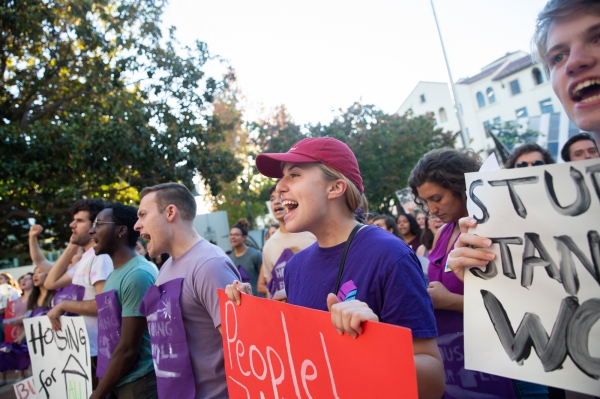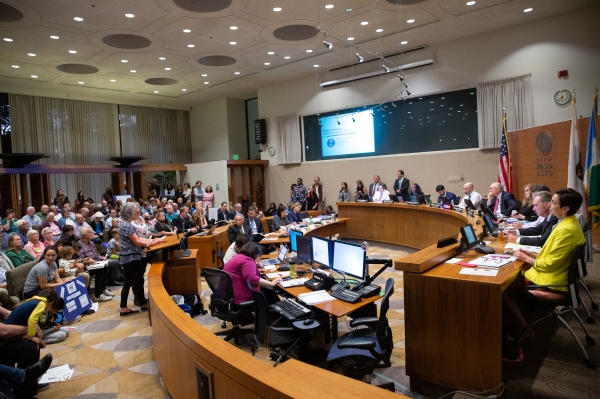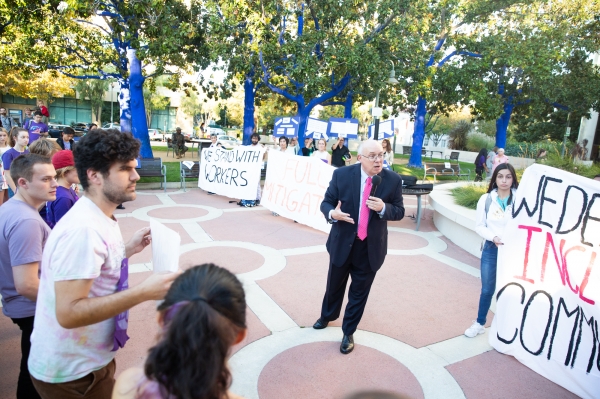With Stanford University's ambitious expansion plan nearing the finish line, hundreds of Stanford students, public school advocates and elected leaders from surrounding communities rallied in Palo Alto on Tuesday to demand that the university do more to address the impacts of its increasingly divisive proposal.
On a day that featured more than 150 students chanting at King Plaza, about 400 spectators cramming into City Hall and roughly 140 speakers addressing the Santa Clara County Board of Supervisors during its rare meeting in Palo Alto, supervisors were besieged with requests that Stanford should be required to provide more housing and transportation services.
With a standing-room-only crowd of more than 250 people packed into the Council Chambers and many others following the meeting from the spillover area in the City Hall lobby, the board heard from area residents, Stanford students and elected officials, many of whom requested that Stanford be required to fully mitigate the expected impacts of its expansion on housing and traffic. Supervisors also heard from several advocates of Stanford's expansion plan, who emphasized the value that Stanford brings to the region and urged the county to approve its expansion request.
One issue that remained unresolved by the end of the meeting was Stanford's commitment to the Palo Alto Unified School District. Last month, the district's Board of Education celebrated a letter that it had received from Robert Reidy, Stanford's vice president for land, buildings and real estate, stating that the university remains "unequivocally committed" to the $138 million agreement that it reached with the school board last spring. That tentative agreement hinged, however, on Stanford negotiating a development agreement with the county, a condition that prompted the county to back away from its own negotiations with Stanford.
At its Sept. 24 meeting, school board members and Superintendent Don Austin lauded Stanford for remaining committed to providing funding for schools, with the understanding that it no longer depends on a development agreement. At that time, board member Ken Dauber called Reidy's Sept. 23 letter a "rock solid commitment" that is "as clear as can be," while board member Shounak Dharap celebrated it as a "great agreement" that is "not conditional on a development agreement."
On Tuesday, however, school officials learned that their celebrations may have been premature and that Stanford's commitment isn't as unequivocal as they had believed it to be. Rather, it remains dependent on a development agreement between Stanford and the county, the very condition that doomed the prior deal between the two educational institutions. Reidy confirmed that under direct questioning by Board of Supervisors President Joe Simitian, who asked him whether Stanford's commitment is as "rock solid" as school board members made it out to be.
"We made it very clear that those funds will be delivered, provided – and appropriately provided – that we have predictability for the future in the form of a development agreement," Reidy told the board.
Simitian also pointed to a recent analysis by the county showing that Stanford's tax-exempt status results in a revenue reduction of $95.9 million for all local jurisdictions in the county, including a $44.5 million for the Palo Alto Unified School District. Simitian noted that any time more students are added to district without additional revenues from property taxes, the per-pupil amount available for instruction goes down. This particularly holds true for "locally funded" districts like Palo Alto, which rely largely on local taxes to pay for education.
"By virtue of that status, it's always going to mean that you'll have fewer dollars per kid," Simitian said.
Simitian told Reidy that absent contributions to the school district, the Board of Supervisors might struggle to make the required legal finding that the Stanford project is not "detrimental to public health safety and general welfare."
"I don't know how we can possibly make the finding that the proposed use will not be detrimental to public health, safety and general welfare if it means every student in the Palo Alto Unified School District will receive $5,000 less in the way of instruction and a 10% reduction (in funding)."
Stanford students brought their own concerns to Tuesday hearings. About 200 undergraduate students, many affiliated with the group SCoPE 2035 (Stanford Coalition for Planning an Equitable 2035), came to the meeting to insist that Stanford offer more housing and transportation services for employees. Some urged the board not to negotiate a development agreement with Stanford unless the negotiations are transparent and Stanford agrees to provide more affordable housing and meet its commitment to the local school district.
Graduate students, many affiliated with the group Stanford Solidarity Network, similarly called on the university to do more to support its workforce by providing more affordable housing and child care services. Members of the group argued Tuesday that Stanford's graduate students face a significantly higher financial burden than their counterparts at other elite universities.
The group also estimated that only about 15% of existing graduate-student housing at Stanford can be considered as "affordable," which they define as costing no more than 30% of the resident's income.
"This crisis is exacerbated for students with significant childcare and dependent healthcare expenses, as well as international students with visa stipulations prohibiting their families from receiving public benefits and barring dependents from working," Stanford Solidarity Network said in a news release. "Though the Stanford University administration emphasizes that 'affordability' is one of its key concerns at present, current development, as well as future construction under the GUP, is projected at rent levels that will only further intensify the crisis of affordability for graduate students."
Alexa Russo, a member of Stanford Solidarity Network, said the group is concerned about the impact of Stanford's expansion on both staff and graduate students.
"While we do different jobs, we are linked by a dire need for affordable housing and concerned about equity implications of Stanford's development plans, not only for us but for the community as a whole," Russo said.
Justine Modica, who was one of about two dozen graduate students who addressed the board, also joined the rally before the meeting, where she suggested that Stanford should devote a greater share of its $27-billion endowment to assist its graduate students. Modica said that while she doesn't have children, Stanford's failure to provide more assistance to graduate students severely limits their options.
"Stanford cuts its graduate students no deals for child care. Even the most affordable options are 130% of our yearly stipend," Modica told a crowd of more than 150 at the rally. "If I had a child, I would not be able to complete my studies while keeping my child alive."
The board also heard from supporters of Stanford's expansion, most of them faculty members at the university. Jonathan Levin, dean of Stanford Graduate School of Business, said Stanford's growth is "intrinsically tied up with the excellence of the university." He urged the board to negotiate with Stanford.
"I'd really urge you all as supervisors to at least enter into discussions with Stanford and explore some of the possibilities," Levin said.
The Tuesday meeting was the penultimate hearing on Stanford's application for a general use permit that would allow the university to build 3.5 million square feet of new development by 2035. Often referred to as the largest project in the county's history, the GUP calls for 2.275 million square feet of new academic space and 2,600 student beds. The university has also proposed building 550 housing units for faculty and staff and 40,000 square feet for child care facilities. The county has included in its conditions of approval a requirement for Stanford to build at least 2,172 housing units for staff, a requirement that Stanford has steadfastly opposed.
Stanford has also refused to budge from its position that a development agreement is the best – and potentially the only – way to make its expansion possible, notwithstanding the county’s reluctance to negotiate such an agreement. The university reiterated its position this week, with Reidy arguing in a letter that a development agreement is necessary to give Stanford the certainty it needs before it can offer community benefits.
"It is important to emphasize that a development agreement is the only legislative tool that can provide such predictability – there is no other," Reidy wrote on Oct. 21. "It is undisputed that County laws and regulations that affect Stanford's academic and housing development under the General Use Permit can be changed absent a development agreement."
County officials have rejected this position in the past, noting that the county has never approved any project (including Stanford's last GUP in 2000) using a development agreement, a tool that didn't even exist before the county agreed to make it available in October 2018.
County staff had also argued that Stanford's offer fails to deliver the type of benefits the university has suggested it does. Stanford had argued that its offer includes "extraordinary benefits," which it estimates would cost more than $4.7 billion. County staff have rejected that figure, noting that Stanford is including in its tally many aspects of the project itself, including 1,600 beds for graduate students. Actual benefits, according to the county, total only about $168 million, roughly 3% of what Stanford claims.
With public comments stretching for nearly four hours, the board didn't deliberate on the general use permit, opting to continue its hearing to Nov. 5, its final scheduled meeting on the Stanford application. That meeting is scheduled for 1:30 p.m. at the County Government Building, 70 W. Hedding St., San Jose.
At the rally before the meeting, speakers also urged the university to do more for its workers and graduate students. Armed with signs (some of the messages read "Housing for All," "We stand with workers" and "Maximum Affordable Housing Now") and a bullhorn, more than 150 students chanted and spoke about the need to hold Stanford accountable.
"Student pressure is absolutely vital in forcing Stanford to create decisions that are inclusive in their scope and make sure to take into account repercussions that go beyond the Stanford campus," Erica Scott, president of the Associated Students of Stanford University, told a cheering crowd, which minutes later broke into chants of, "Hey hey, ho ho / Exploitation's got to go!" and "Housing is a right! That is why we have to fight!"
Students weren't the only speakers to offer reservations about Stanford's growth plan. Council members from various cities around Stanford, including Palo Alto, East Palo Alto and Menlo Park also pushed for "full mitigation." East Palo Alto Councilman Carlos Romero urged Stanford to expand its network of Marguerite shuttles to serve workers in nearby commuters.
"It is critical that the low-income workers in East Palo Alto who work and staff the various areas at Stanford should have the ability to get to Palo Alto through that service," Romero said. "It's a type of TDM (transportation-demand management) that both cities and Stanford can benefit from."
Menlo Park Councilwoman Betsy Nash also requested more transportation services from Stanford, which she said are necessary to address the city's traffic and housing challenges.
"It's hard to overstate how serious the adverse impacts of that expansion will be," Nash said.





Comments